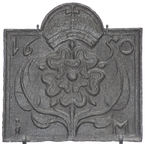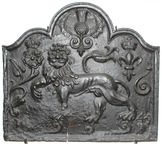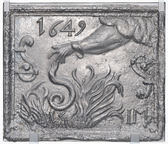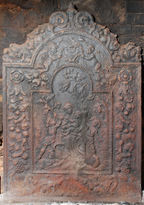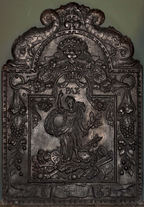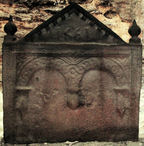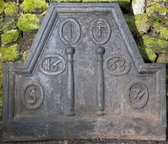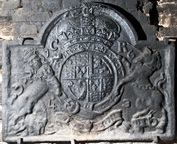-
750
Description: Arched rectangular shape; cavetto edging; crowned rose with symmetrical leaves; date split across top; initials split across bottom.
Notes: The hooked ‘1’ and ‘IM’ suggests a common pattern-maker with other firebacks bearing those features.
Copies of this fireback are known.
Inscription: 16 50 / I M
- Decoration tags:
- rectangular with round arch (shape)
- cavetto (edging)
- whole carved pattern
- planklines
- heraldic
- royal
- text
Manufactured: in 1650 possibly at Brede Furnace in the Weald area of England.
Current location: Victoria & Albert Museum, Cromwell Road, Kensington & Chelsea, Greater London, England.
Museum number: M.113-1953 (part of the Victoria & Albert Museum museum group)
- Attached to series:
- IM series
- Small cavetto series
- Hooked '1' series
- Brede group
-
763
Description: Quasi-Arched rectangular shape with cyma reversa shoulders; ovolo edging; stylised lion passant guardant; crowned rose with leaf and stem on left, crowned fleur de lys on right, thistle with leaves above centre; three right-facing scrolls at base; down-facing scroll, with staple, on right side; date split between bottom corners; initials below date, bottom right.
Notes: Blatantly Royalist in its symbolism, a variant (no. 901) is dated (perhaps more convincingly) 1641. Numeral style, initials, leaf depiction and the stapled scroll are typical features of firebacks made from patterns by the same maker. A later version of the same subject, but with a different shaped plate and without the fleur-de-lys, is also known (see 'Royalist series'). M. A. Lower writes of firebacks of this design of being cast at Waldron Furnace in Sussex (Lower, 1849, p.219).
Copies of this fireback are known.
Inscription: 16 49 / IM
- Decoration tags:
- rectangular with round arch (shape)
- ovolo (edging)
- whole carved pattern
- heraldic
- royal
- text
- animals
Manufactured: in 1649 possibly at Brede Furnace in the Weald area of England.
Current location: Victoria & Albert Museum, Cromwell Road, Kensington & Chelsea, Greater London, England.
Museum number: 492.1901 (part of the Victoria & Albert Museum museum group)
Citation: Lloyd, N., 1925, 'Domestic Ironwork I', Architectural Review, 58, pp. 58-67.
- Attached to series:
- IM series
- Hooked '1' series
- Stapled scroll series
- Brede group
-
769
Description: Rectangular; cavetto-moulded edge; a snake rises from a fire and bites the middle finger of the hand of a sleeved left arm that descends from a top right corner cloud; left and right, ‘S’ scrolls appear strapped to the edge of the fireback; the date, top left of centre; initials, bottom right corner.
Notes: An illustration of the New Testament episode (Acts 28: 3) when St Paul, shipwrecked in the island of Malta, was putting sticks on a fire and a viper bit him. The distinctive shape of the ‘1’ in the date and the initials, ‘IM’, together with the ‘S’ scrolls, parallel such features in other firebacks. The design is an adaptation of an illustration in 'Devises Heroiques' by Claudius Paradin (1557) which was translated into English by Geoffrey Whitney as 'The Book of Emblemes' (1586).
Copies of this fireback are known.
Inscription: 1649 / IM
- Decoration tags:
- rectangular (shape)
- cavetto (edging)
- whole carved pattern
- biblical
- text
- animals
- humans
Manufactured: in 1649 possibly at Brede Furnace in the Weald area of England.
Current location: Victoria & Albert Museum, Cromwell Road, Kensington & Chelsea, Greater London, England.
Museum number: M.119-1984 (part of the Victoria & Albert Museum museum group)
Citation: Hamling, T., 2010, Decorating the 'Godly' Household (New Haven, Yale), pp. 251-2.
- Attached to series:
- IM series
- Hooked '1' series
- New Testament firebacks
- Brede group
-
895
Description: Quasi-arched rectangular shape, semi-circular protrusions on top corners; cavetto-moulded edging looped at top; two mirrored scrolls inside arch; a phoenix in flames, its wings displayed and inverted; date, in two parts, in top corners; initials in bottom right corner.
Notes: On a copy (no. 590) the loop at the top is missing and the date and the initials have been erased.
Copies of this fireback are known.
Inscription: 16 50 / IM
- Decoration tags:
- rectangular with round arch (shape)
- cavetto (edging)
- whole carved pattern
- pictorial
- mythological
- text
- animals
Manufactured: in 1650 possibly at Brede Furnace in the Weald area of England.
Current location: not known.
- Attached to series:
- Hooked '1' series
- IM series
- Loop edged firebacks
- Brede group
- Phoenix firebacks
-
784
Description: Arched rectangular centrel panel with bead on fillet edging; central seated female with an infant in her arms, a swan at her feet and a standing child on each side, the one to her left facing the front and holding aloft a flaming heart, its foot on a ball; the child to her right facing the back, holding aloft a branch in its left hand, all on a ground with a tree behind to the right; arched rectangular border with bead edging; fructal and floral festoons suspended on ribbons with two putti at the top and two on each side; at the bottom, a central cartouche with illegible date, between floral swags; on top, twin spirals between descending floral festoons.
Notes: The group is an allegory of Charity. A recasting.
Copies of this fireback are known.
- Decoration tags:
- 'Dutch' (shape)
- ovolo (edging)
- whole carved pattern
- pictorial
- allegorical
- humans
Manufactured: in the mid-17th century in the Siegerland area of Germany.
Current location: in private hands, West Hoathly, West Sussex, England.
- Attached to series:
- 'Dutch' HHS series
- Charity firebacks
-
612
Description: Arched rectangular central panel with astragal edging; allegorical figure of Peace, her right arm raised and her left hand holding an olive branch, standing amid the weapons of war; above her swags of drapery and fruit enclosing the word, PAX; arched rectangular shaped border with ovolo-moulded egg and dart edging; top centre, lion's face from which issue festoons of fruit and leaves which descend down each side, suspended from rings; at the bottom, a motto scroll bearing the date; on top, the face of a putto between two descending fish.
Notes: A more-than-usually elaborate border to a typical central panel.
Inscription: PAX / 16 63
- Decoration tags:
- 'Dutch' (shape)
- ovolo, egg and dart (edging)
- whole carved pattern
- pictorial
- allegorical
- text
- humans
- plants
- objects
Manufactured: in 1663 in the Siegerland area of Germany.
Current location: not known.
- Attached to series:
- 'Dutch' Miscellaneous Firebacks
-
925
Description: Rectangular panel with moulded edging (top and sides); two joined guilloche arches with bracket ends and floral designs in the spandrels; above, pediment with dentil edging, between teardrop pinnacles; date in bottom centre of pediment; possible initials below and between arches.
Notes: The pattern has been formed from, or in imitation of, the upper part of the back of a joined 'wainscot' chair with an inserted date and possible inserted initials
Inscription: 1661 / [?W] [?H]
- Decoration tags:
- rectangular with triangular arch (shape)
- complex, furniture-derived (edging)
- whole carved pattern
- individual numbers
- architectural
- text
Manufactured: in 1661 in England.
Current location: in private hands, Wigmore, Herefordshire, England.
- Attached to series:
- Chair pattern firebacks
- Furniture stamp firebacks
-
1061
Description: Triple-facetted arched rectangular shape; ovolo-moulded edging (top and sides); bottom centre, a vertical distaff or spindle repeated twice; to each side a fillet-edged oval containing the initials S and W; above, either side of the distaffs, two more ovals perpendicular to the first two, with the date split between them; above each distaff, an oval rotated as at the bottom, the initials I T split between them; at the base, a blank rectangular panel.
Notes: An unusual shaped fireback. It was recorded by J. Starkie Gardner in one of his scrapbooks (Victoria and Albert Museum, Archive of Art and Design (AAD/2014/8)), marked '[?]Warris Westerham Kent'; subsequently it was at Skipreed, Chiddingstone Hoath, Kent.
Inscription: I T / 16 63 / S W
- Decoration tags:
- rectangular with triple-facetted arch (shape)
- ovolo (edging)
- carved stamps
- text
- objects
Manufactured: in 1663 possibly in the Weald area of England.
Current location: not known.
- Attached to series:
- Miscellaneous stamp firebacks
- Spindle/distaff firebacks
-
1303
Description: Arched rectangular shape; cavetto edging; armorial; Stuart English royal arms within a circular garter; crown, motto and supporters (crowned lion and unicorn); initials separated by cro wn; date - 1643 - inserted outside Garter.
Notes: A widely copied fireback with the date, 1643, probably spurious, inserted when copied. An earlier casting without the date is no. 350.
Inscription: C R / 1 6 / HONI SOIT QVI MAL Y PENSE / 4 3 / DIEU ET MON DROIT
Arms: English Stuart royal
- Decoration tags:
- rectangular with round arch (shape)
- cavetto (edging)
- whole carved pattern
- individual numbers
- heraldic
- armorial
- royal
- text
Manufactured: in the mid-17th century in England.
Current location: in private hands, Worth, West Sussex, England.
- Attached to series:
- Carolean royal armorial firebacks
- Stuart royal armorial firebacks
-
1204
Description: Arched rectangular shape; ovolo moulded edging; date in arch; below arch two parallel, vertical straps, each with a buckle at the top and six prong holes; initials left and right of centre; in top corners, rectangular framed stamp with inset bird; top centre, to left and right of buckle, circular 'butter mould' stamp with stylised fleur-de-lys design, the left one angled top to left; between each initial and strap, rectangular framed stamp with inset deer with antlers, and star in top left corner; below this, adjacent to each strap end, a circular stamp with symmetrical pattern; to left and right of this, a rectangular stamp with an unidentified animal, possibly a dog..
Notes: The buckles, the date and the initials all appear to be separate stamps but attached to the base board before being impressed to form the mould, as they are identically positioned on all castings. The buckles suggest a connection with the Pelham family; the initials may relate to Sir Thomas Pelham, Bt. (1597-1654) who owned and operated ironworks at Waldron in Sussex. This would appear to be a casting of the original pattern with the addition of five pairs of stamps. The circular stamp with the symmetrical pattern is probably the same stamp that has been noted on an otherwise unrelated fireback (no. 733). Some of the stamps are seen in greater profusion on a fireback formerly at Huggetts Farm, Waldron, Sussex (no. 966) and drawn by Edward Hughes, of Heathfield, in a scrapbook of images compiled by J. Starkie Gardner. Nicholson's auction, Fernhurst, 3 Jul 2021, lot 100 (£5); Bellman's auction, Wisborough Green, 18 Feb 2025, lot 746 (£600).
Inscription: 1642 / T P
- Decoration tags:
- rectangular with round arch (shape)
- ovolo (edging)
- carved stamps
- whole carved pattern
- planklines
- text
- animals
- objects
Manufactured: in 1642 probably at Waldron Furnace in the Weald area of England.
Current location: not known.
- Attached to series:
- 1642 Pelham series
- Food mould stamp firebacks
- Pelham family firebacks
